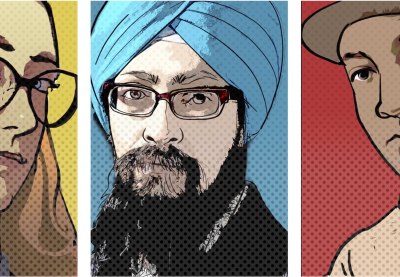In her new documentary, Drawn Together: Comics, Diversity and Stereotypes, Harleen Singh introduces viewers to three comics creators who use their artwork to push back against bigotry and stereotypes. Keith Knight uses his platform as a syndicated comic writer to address racial injustice and police brutality, including the Black Lives Matter movement. As Sikh Captain America, Vishavjit Singh pairs the iconic cape and shield with his everyday turban and beard. And Eileen Alden confronts gendered stereotypes with strong female characters who aren’t interested in playing damsels in distress. TT Associate Editor Julia Delacroix recently sat down with the filmmaker to discuss the power of comics.
Why did you choose comics?
We all grew up around comics, right? Comics are this universal medium for entertainment, and it spans generations, religions, cultures, borders—you call it—anything. Everybody connects with comics. ... The characters that are featured in comics have become like this core part of our culture. We probably sometimes don’t know our neighbors, but we know who Superman or Spider-Man is. ... But, more importantly, I wanted to make a film on a subject like stereotyping and bullying and racism. Now, if a serious subject like this is told in a sort of a lecturing tone, then it doesn’t go well with people. So I wanted to find a medium that connects with a broader audience. Universally, there are three or four mediums [that almost anyone can connect with]. One is music. One is sports. And the other is comics, which connect universally with people.
“Are You a Superhero?” is a short clip from Drawn Together available through Kaur films.
How did you choose these artists to profile in your film?
So, I think, for me the subject came first: racism, bullying, stereotyping. ... And once it was clear that comics was the medium that I want to go along with, it took about six months to research different comic artists, different people who write editorial cartoons. ... And what was interesting was that these three people—Eileen, Vish and Keith—are very different in age, their appearance, their background, upbringing ... the kind of stereotypes that they faced were very different. But there was this really great thread of commonality that was very interesting. That they were all using comics and cartoons to challenge the labels that were put on them.
What did you learn over the course of making this film that you wish you'd known before?
When I started this concept, I was a fan of comics and I liked them, but I did not understand the power that they actually have. The extent of influence that they have over people from all kinds of backgrounds was just fascinating. ... You know, usually as adults we keep our guards up, but if [an idea is shared] through cartoons and comics, we do not have those guarded reactions. And that was fascinating.
When I went to San Diego Comic-Con, when we shot there, we spoke to so many people. Eyes were lit up with every single reaction that we got. ... I mean, there were people who were coming there for like 27 years. They were bringing their children and grandchildren. We went and showcased [Drawn Together] to people from different backgrounds to get their reaction. ... And, across the board, the kind of reactions that we got, we were like, Wow.
What do you wish people understood about using comics to fight for change?
One of the bigger things that we realized was a lot of people think that racism and bigotry need a lot of machinery around to tackle these challenges. But, in our case, through the film, we show that there are people who are [fighting inequity] with deceptively simple yet powerful tools. Change can happen with just drawing something or changing a costume.
Doing all these focus groups, we realized that [when people] see a story on screen, it changed their perception. A simple story told effectively can change perception.
Delacroix is the associate editor for Teaching Tolerance.


0 COMMENTS